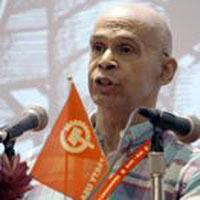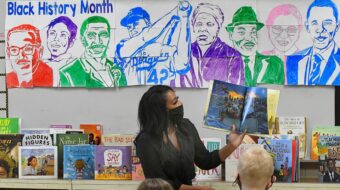
In response to the police murders of Michael Brown and Eric Garner and the failure of grand juries to return indictments, a new movement for justice has emerged.
Sparked by the initiatives of young African Americans and joined by the civil rights and labor movements new coalitions, like #ThisStopsNow and #HandsUpUnited have dramatically brought the issue of police crimes front and center: #BlackLivesMatter. By means of sit-ins, die-ins, picket lines, and blocking highways and bridges, young protesters are demanding that the murders must immediately end and that the racist criminal justice system be radically reformed.
Beginning with the Ferguson protests last August, this movement is now assuming a national character.
Outraged by the refusal of the Staten Island grand jury to indict inspite of videotaped proof of gross police misconduct demonstrations have occurred daily with thousands of participants in close to 20 states. #ICantBreathe has become the rallying cry of the rising protests. Particular note must be taken of its growing multi-racial character.
The labor movement has lent support and AFL-CIO president Richard Trumka has challenged union members and beyond to fight racism and build unity.
This independent movement has established its own demands and priorities. Whether or not they are met will depend on the breadth and depth of the coalitions that are in formation and their ability to involve ever-broader sections of the U.S. public. Union leaders and elected officials are now getting arrested and joining the die-ins, putting their bodies on the line. Sports figures and other prominent personalities are speaking out.
Importantly the NAACP sponsored a weeklong march to Missouri’s state capital and a national march on Washington has been called for Dec. 13.
In this regard, building unity around the movement’s demands is a top priority. Among the obstacles to such unity are divergent views on the role of the criminal justice system, narrow concepts of coalition; inadequate understanding of institutionalized racism and its beneficiaries; tactics; and ongoing efforts to promote division along political and generational lines.
Significant differences persist on the impact of racism with regard to Michael Brown’s murder. Recent polls indicate “62 percent of whites having “some” confidence in a fair investigation, compared to just 35 percent of blacks. Nearly 60 percent of African Americans have not much or no confidence it will be fair.”
What is the basis for these differences? Clearly lived experiences are determining factors. Large percentages of African Americans have personal experience with police racism. The New York Times writes, “Some 45 percent of blacks – and 58 percent of black men – say they have personally been discriminated against by the police because of their race, compared to just 7 percent of whites.”
Racial profiling, stop-and-frisk policing, sentencing disparities to say nothing of a veritable state of siege in communities of color have fed the growing mistrust and lack of confidence in fair judicial outcomes. Added to this are the recent spate of high profile murders of African Americans by both civilians and police in which the culprits go scot-free. It’s small wonder then that young people are particularly outraged and growing ever more radicalized by these patent injustices.
A more difficult question is how in these circumstances can greater unity be built? Is there a minimum basis for cooperation and if so on what issues? In the first place it should be noted that on key questions white and black communities are not worlds apart – on a few there is broad agreement. For example, broad sections oppose the militarization of local police departments: “Most whites (65 percent), and even more blacks (80 percent), do not think local police forces should have military weapons and equipment. Majorities of Republicans, Democrats, and independents agree.”
Similarly there is a wide consensus on requiring police forces to use body cameras with over 75 percent favoring the measure.
But what of the more problematic issues? How has racism changed and modulated in relation to shifting thought patterns and conditions and to what degree do these changes impact the ability to achieve unity.
Clearly a complex and contradictory pattern emerges. Ruling class racism beginning with the GOP-led assault on the foundations of the New Deal and Great Society has intensified. Welfare reform, mandatory minimum sentencing laws, the trying of teenagers as adults, the war on drugs, deindustrialization, the sub-prime crisis, voter suppression, stop-and-frisk policing, attacks on reproductive rights, all have had a sharply racist edge and effect. Added to this are the accompanying ideological campaigns, popularly referred to as “culture wars” that criminalize young men and victimize young women, particularly single mothers.
A 2012 AP study concluded “51 percent of Americans now express explicit anti-black attitudes, compared with 48 percent in a similar 2008 survey.” A poll taken a year earlier regarding Latinos produced similar results. In “2011, 52 percent of non-Hispanic whites expressed anti-Hispanic attitudes.”
On the other hand, the last quarter century witnessed major shifts in mass consciousness marked by an ideological setback for the most vicious forms of racist ideology. Accompanying it was a growing acceptance of black and brown leadership in both public office and civil society, a marked increase in interracial relations and marriages, along with a major shifts in the U.S.’s multi-racial demographic.
Among white Americans a marked anti-racist trend gained strength. Some 20 to 30 percent vote for African American candidates with higher figures for union members and particularly younger voters. There is also a large and muddled “non-racist” middle: a group that while not consciously anti-racist have rejected its most overt features. It is among this section of the population that the concepts of colorblindness hold most sway.
How to engage and win this broad middle to a greater understanding of racism and particularly its institutional forms and character is a major challenge.
What are the best means and arguments here for conveying the ongoing reality of unfair treatment accorded to black, brown, Native American and Asian Americans based on race?
Various arguments here are in contention, some moral, others based on self-interest. The idea that racism accords whites a special privilege has gained wide currency. In broad popular usage the term ‘white privilege” refers simply to the absence of special forms of discrimination and the need for greater awareness of its effects. At the same time it’s also the case that demands are made that such privilege be given up, meaning that an alleged accrued benefit be sacrificed.
Challenges to white privilege argue that the concept is classless and that beneficiaries of racism are hardly equal. Because of racism employers gain greater wealth and power and all employees lose, including whites when bargaining power and solidarity is lessened. Additionally the question is asked, what should be given up and by who, in circumstances where capitalists are reaping huge profits. Wouldn’t all workers gain by placing the onus on those who benefit most? Here self-interest to say nothing of fairness is seen to be the stronger argument.
But what about what happens when one steps outside of the shop floor and is profiled on the way home from work; or denied a loan or rental, or refused hospitalization because of lack of health insurance, or picks up a child from a re-segregated school with inferior books and supplies or is unable to go to the university because of spiraling tuition? The existence of an ongoing racist social division of labor is undeniable.
On the other hand, wage stagnation, lack of insurance, low-wage jobs, student debt, denial of reproductive rights, unemployment, speedup, etc, affects whites as well. The alleged racial benefits for those struggling to make ends meet are hard to see.
When addressing the issue of racism in the “superstructure” (the legal system, education, etc.) as elsewhere, the argument has to be made time and again that its elimination is in the interests of all concerned. Ending racial profiling, the war on drugs, legalization will mean less arrests, less return offenders, more employable people able to work. So too with reforms in the grand jury system, the creation of civilian police review boards – and the lists goes on.
Finally successful approaches to building unity on these issues will have to take into account the life experiences of different generations: boomers; Generation X, Generation Y and Millennials.
The economy that gave rise to the civil rights/labor alliance forged by Boomers and that shaped the reforms experienced by generation X in the 1960s has been radically reshaped and with it the demands and needs of following generations. Even the “counter revolution” engineered by Reagan conservatives and their latter day followers while experienced by Generation Y came after the birth of today’s Millennials beset by enormous student debt and coming from communities ravaged by the Great Recession. It is this generation, socially aware, racially tolerant, politically left and liberal but increasingly disengaged from political parties that have taken to the streets en masse demanding an end to police crimes and murder.
It is also this generation that is the mass base of today’s low-wage worker movement. Already in Ferguson and elsewhere unity of action is growing out of these struggles and with good reason.
To those who counsel patience it is likely that they will say as King said, “we cannot wait.” Channeling that anger, building unity around its righteous indignation, providing strength for the long haul and helping convince the unconvinced is the task that is at hand. Meeting it is challenge of the day.
Photo: Some 25,000 people marched in New York City on Dec. 13 demanding justice for Eric Garner and all victims of racism and police violence. Protests were also held across the country and in the nation’s capital. (B.C. Lorio/CC/Flickr)

MOST POPULAR TODAY


Zionist organizations leading campaign to stop ceasefire resolutions in D.C. area

Communist Karol Cariola elected president of Chile’s legislature

Afghanistan’s socialist years: The promising future killed off by U.S. imperialism

High Court essentially bans demonstrations, freedom of assembly in Deep South






Comments